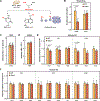Formaldehyde regulates S-adenosylmethionine biosynthesis and one-carbon metabolism
- PMID: 37917677
- PMCID: PMC11500418
- DOI: 10.1126/science.abp9201
Formaldehyde regulates S-adenosylmethionine biosynthesis and one-carbon metabolism
Abstract
One-carbon metabolism is an essential branch of cellular metabolism that intersects with epigenetic regulation. In this work, we show how formaldehyde (FA), a one-carbon unit derived from both endogenous sources and environmental exposure, regulates one-carbon metabolism by inhibiting the biosynthesis of S-adenosylmethionine (SAM), the major methyl donor in cells. FA reacts with privileged, hyperreactive cysteine sites in the proteome, including Cys120 in S-adenosylmethionine synthase isoform type-1 (MAT1A). FA exposure inhibited MAT1A activity and decreased SAM production with MAT-isoform specificity. A genetic mouse model of chronic FA overload showed a decrease n SAM and in methylation on selected histones and genes. Epigenetic and transcriptional regulation of Mat1a and related genes function as compensatory mechanisms for FA-dependent SAM depletion, revealing a biochemical feedback cycle between FA and SAM one-carbon units.
Conflict of interest statement
Competing interests
D.K.N. is a co-founder, shareholder, and adviser for Artris Therapeutics and Frontier Medicines. All other authors declare no competing interests.
Figures





References
-
- Tibbetts AS, Appling DR, Compartmentalization of mammalian folate-mediated one-carbon metabolism. Annu. Rev. Nutr. 30, 57–81 (2010). - PubMed
MeSH terms
Substances
Grants and funding
LinkOut - more resources
Full Text Sources
Molecular Biology Databases

